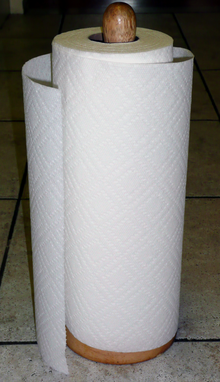Paper towel

A paper towel (or kitchen paper) is an absorbent towel made from tissue paper instead of cloth. Unlike cloth towels, paper towels are disposable and intended to be used only once. Paper towels soak up water because they are loosely woven which enables water to travel between them, even against gravity. Paper towels can be individually packed (as stacks of folded towels or held coiled) or come in rolls. Paper towels have similar purposes to conventional towels, such as drying hands, wiping windows, dusting, and cleaning up spills.
History

In 1907, the Scott Paper Company of Philadelphia, Pennsylvania, introduced paper tissues to help prevent the spread of colds from cloth towels in restrooms.[1] Popular belief is that this was partly accidental and was the solution to a railroad car full of long paper rolls meant for toilet paper that were unsuitable to cut into rolls of toilet paper.[2] In 1919, William E. Corbin, Henry Chase, and Harold Titus began experimenting with paper towels in the Research and Development building of the Brown Company in Berlin, New Hampshire.[3] By 1922, Corbin perfected their product and began mass-producing it at the Cascade Mill on the Berlin/Gorham line.[4] This product was called Nibroc Paper Towels (Corbin spelled backwards[5]). In 1931, the Scott Paper Company of Philadelphia, Pennsylvania, introduced their paper towel rolls for kitchens; they are now the leading manufacturer of paper towels.
Production
Paper is made from either virgin or recycled paper pulp[6] which is extracted from wood or fiber crops. They are sometimes bleached during the production process to lighten the paper's coloration.[7] It is not uncommon for rolls of paper towels to include intricate colored images on each square (such as flowers or teddy bears). Resin size is used to improve the wet strength.[7] Paper towels are packed individually and sold as stacks, or are held on a continuous roll, and come in two distinct classes: domestic and institutional.[8]
Market
Tissue products in North American, including paper towels, can be divided into "consumer" and "commercial" markets, with household consumer usage accounting for approximately two thirds of total North American consumption.[9] Commercial usage, or otherwise any use outside of the North American household, accounts for one third of North American consumption.[9] The growth in commercial use of paper towels can be attributed to the migration from folded towels (in public bathrooms, for example) to roll towel dispensers, which reduces the amount of paper towels used by each patron.[9]
Within the forest products industry, paper towels are a major part of the "tissue market", second only to toilet paper.[9] Consumption of paper towels and other tissue products is highest in the United States of America at approximately 24 kilograms per capita, 50% higher than in Europe and nearly 500% higher than in Latin America.[9]
Marc Jacobs, the creative director for Louis Vuitton and head designer for Marc Jacobs and diffusion line Marc by Marc Jacobs, designed a raincoat made entirely of paper towels for his 2014 Resort Line.

See also
References
- ^ "Learn about Scott® Community and Scott® Brand".
- ^ "Paper Towel History - Invention of Paper Towels".
- ^ "It felt like death". Retrieved December 30, 2011.
- ^ "Once Upon A Berlin Time". Retrieved December 30, 2011.
- ^ "Beginnings of the Cascade Paper Mill" (PDF). Retrieved December 30, 2011.
- ^ "Frequently Asked Questions". quickerpickerupper.com. Archived from the original on 2007-06-09. Retrieved 2007-06-28.
- ^ a b Sasser, Sue Lynn. Paper Towels from the Texas A&M website. Retrieved on June 29, 2007
- ^ Brad Kalil, Director of Tissue (October 2008). "Tissue market continues to grow". Pulp & Paper Int'l Digital Edition. RISI. Retrieved 2009-10-31.
- ^ a b c d e Brad Kalil, Director of Tissue (October 2008). "Tissue market continues to grow". Pulp & Paper Int'l Digital Edition. RISI. Retrieved 2009-10-31.
External links
![]() Media related to paper towels at Wikimedia Commons
Media related to paper towels at Wikimedia Commons
